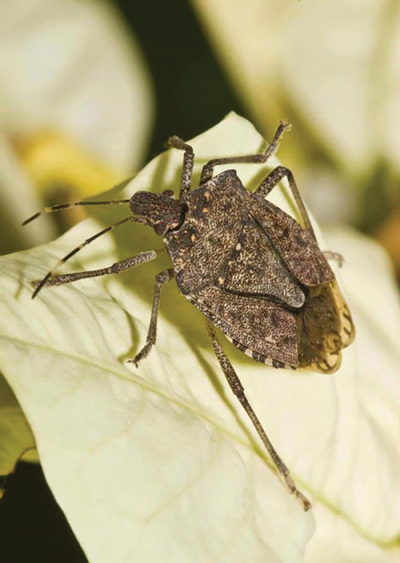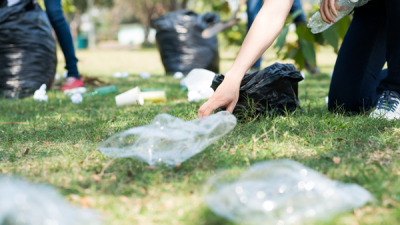
Brown marmorated stink bugs arrived in the United States from Asia in 1996, spreading from Pennsylvania into Michigan in 2010.
Photo by Susan Ellis, Bugwood.org
METRO DETROIT — As the days get shorter and the air cooler, the telltale signs of fall emerge: cider and donuts, gourds, pumpkin spiced lattes and, of course, the great stink bug hibernation.
Homes throughout metro Detroit will be breached and besieged by the bumbling but harmless brown marmorated stink bug this fall and winter, seeking safe shelter over the darker months.
“When we get about less than 13 hours daylight, there is a chemical change within the stink bug that makes it move from reproducing and feeding to searching for a place to spend the winter,” said David Lowenstien, a Michigan State University Extension consumer horticulture educator. “Naturally, stink bugs will spend the winter in leaf litter or tree bark, but where there’s a lot of homes or barns or sheds, that can be a more protective place to spend the wintertime.”
Making their way inside through the smallest of cracks and crevices, brown marmorated stink bugs choose to spend their time doing as little as possible. The daylight-induced chemical change prohibits them from reproducing, and they cannot find food indoors, so they spend the months doing as much as they can to save their energy.
Brown marmorated stink bugs are an invasive species of stink bug. It was first detected in the United States in 1996 in Allentown, Pennsylvania, possibly arriving stateside by hitching a ride in shipping containers from either China or Japan. They then spread across the eastern U.S.
“Around the 2000s was when the mid-Atlantic fruit growers really became very alarmed by them and had a lot of fruit damage in their orchards,” said Julianna Wilson, a Michigan State assistant professor of tree fruit entomology.
Brown marmorated stink bugs have a long straw-like mouth, which they use to suck the juices of fruits, vegetables and other plants. This leaves a lumpy, brown and cork-like plant drained of its juices, potentially ruining whole crop yields. As the bugs made landfall in Michigan in 2010, finding a way to manage the stink bug was a top priority for agricultural scientists.
Ultimately however, the brown marmorated stink bug never became as much of an agricultural threat as it was on the Atlantic coast. For one, there is a large variety of food sources for stink bugs in Michigan, allowing the bugs to spread out and not target only a select few crops. Parasites have also played a role in managing the brown marmorated stink bug. A microsporidian, or parasitic fungus, found to infect native stink bugs has made the jump to the brown marmorated stink bug, reducing the bugs ability to lay eggs when populations grow too large.
Another nonnative insect species from Asia, the samurai wasp, has made its way to the U.S. and preys on brown marmorated stink bug populations. The tiny one-eighth of an inch long black wasp specializes in attacking brown marmorated stink bug eggs, using the eggs to lay their own larvae. The samurai wasp is incapable of stinging humans and has not been observed targeting native stink bug eggs.
“(The samurai wasp) came here (and) we haven’t seen any big effects other than with this particular stink bug, which it does really well on in its native host range,” Wilson said. “It has not become the pest that we thought it would become.”
While research into brown marmorated stink bug management is still ongoing, the species has largely found its place in the environment.
“We have the tools we need when they’re needed to be able to combat this pest,” Wilson said. “We’re not in the, ‘Oh no it’s an invasive species’ stage anymore. It’s here and established and we know how to deal with it, so it’s not an emergency or big concern like it was.”
In the home, the biggest threat brown marmorated stink bugs post to humans is increased irritation. A stink bug sighting is commonly marked by the brown guitar pick-shaped creature slowly stumbling out from a windowsill or curtain or some other hiding place. Perhaps once disturbed they will take flight, flapping wings and meandering through the air with all the subtlety of a 747. And should you try squishing one, its namesake cilantro-scented pheromone will stink up the air around where it is struck down.
“They’re a moderate garden pest,” Lowenstien said. “The main issue with brown marmorated stink bugs are nuisance issues in the fall when they might congregate inside or outside of people’s homes … The only risk would be squishing them on fabrics; I would not recommend squishing them on furniture or squeezing them indoors, because they will release that smell, and they can stain furniture.”
To get rid of stink bugs indoors, Lowenstien recommends drowning them in soapy water or sucking up stink bugs with a vacuum cleaner. Stink bugs can be trapped into drowning by placing a light over a pan of soapy water; the light will attract the bugs, causing them to fall into the pan.
Keeping stink bugs out of the home, however, is a futile effort. Checking for openings and gaps in walls is the most that can be done, as stink bugs will get inside though any little crack they can find. Stink bugs may congregate on the west and south sides on the exterior of homes in the fall, and spraying them with water or vacuuming them up is enough to remove them.
“Having them inside of your house doesn’t mean that you have failed to protect your home in any way,” Lowenstien said. “Insects are very smart at finding small gaps and cracks to make their way indoors, because they know that winter is coming, too.”
 Publication select ▼
Publication select ▼




















